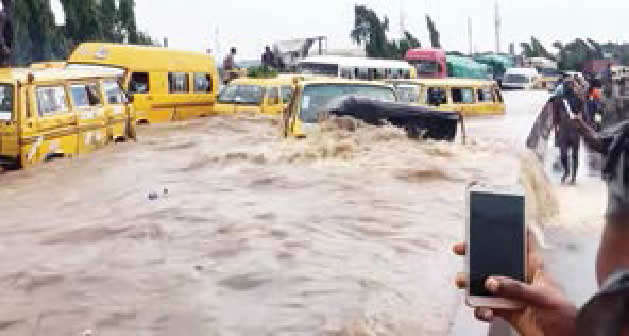Environmentalists urge drainage clearing, remedial works in flood-prone areas, others

[ad_1]

After several days of downpours, reports are rife of how flooding has taken over areas and communities in states. There are photographs and videos on the Internet showing the havocs wreaked by floods.
The United Nations Office for the Coordination of Humanitarian Affairs report for August stated that 17 countries in West and Central Africa experienced heavy rainfall and floods that killed over 250 people, destroyed about 35,000 houses and left 126,000 people homeless. In 2019, the UN reported that Nigeria recorded 158 deaths and 277,555 displaced persons as a result of floods. Its 2020 report reflected an increase with a total of 2,353,647 persons impacted by floods and 69 persons killed.
A European Union funded organisation to monitor and report flood events around the world, FloodList, reported an increase in floods globally. In a timeline of events, in September 2020, the overflow of the River Niger caused several days of flooding in Kogi State which led to the displacement of over 50,000 people, loss of crops and livestock and death of one.
In August 2022, the Nigerian Meteorological Agency predicted that the prevailing weather pattern in Nigeria would cause above-normal rainfall in about 19 states between August and October this year. It stated that the above-normal rainfall conditions were expected in the northern states such as Sokoto, Zamfara, Katsina, Kano, Jigawa, Yobe, Borno, Bauchi, Kebbi and Gombe, including Kaduna and Adamawa states.
The agency’s Director-General, Mansur Matazu, added that normal to above normal rainfall conditions were expected over most parts of the South-West including Lagos, Ogun, Osun, much of Oyo, Ondo, parts of Ekiti, and Edo states.
Between September 2020 and 2021, over 250,000 persons were affected by floods and not less than 188 persons died as a result.
Last week, The PUNCH reported that floods destroyed more than 200 households in Makurdi, Benue State and wreaked havoc in the Moro Moro area of Maiduguri, Borno State.
Also, in Bauchi State, three persons were said to have died, 1,453 houses damaged and several farmlands affected by floods in the Zaki and Gamawa local government areas of the state.
In Lagos State, a building in Maryland sank due to heavy rainfall which left some parts of the area flooded. The prompt call and activities of emergency responders led to the rescue of nine ladies trapped in the building.
Also in Ado-Ekiti, Ekiti State, many residents were reported to have been displaced by flood after heavy rainfall. In July, 100 persons were displaced in Yobe State and four died while in Anambra State 30 shops were destroyed and 17 lives claimed by flooding. In August, Jigawa State recorded 50 fatalities.
Earlier in the month, the National Emergency Agency stated that from January to August, about 372 persons died from floods that ravaged 33 states in the country. It also affected over 508,000 persons, injured 277, destroyed 37,633 houses and submerged several farmlands and livestock.
Usually, plants and wildlife habitats, lives, property and rivers are mostly affected in communities by flooding.
A paper presentation on, “The Impact of Climate Change on Rainfall Patterns in Kaduna State,’’ by Mandé Hosea, noted that recurrent extreme rainfall and effects of climate change were inherent characteristics of rainfall in the region.
It added that climate change also accounted for unpredictability in the onset and cessation of rainfall season and flooding due to heavy storms among others.
However, despite the year-in-year-out flooding situation in the country, the ecological fund, an intervention fund by the Federal Government to fund ecological-related projects, has yet to be effectively utilised.
In June, the House of Representatives resolved to investigate remittances and withdrawals to and from the Ecological Fund between 2010 and 2022. It also tasked the Committee on Ecological Fund to investigate the utilisation of the fund “by benefiting government’s departments and agencies from 2010 to March 2022 and establish any infractions (if any).”
But the worst of the rains and accompanying floods are far from over. The UN, at the end of August, predicted that more rainfall was expected in the West and Central Africa region until October. Though little can be done to prevent rains, effects of the accompanying floods can be mitigated.
Environmentalists and environmental engineers have highlighted blocked drainages and river courses, saturated soil, disregard for building plans in lowlands and climate change as the main causes of floods.
In his comment on the issue, a professor of Environmental Sustainability, Environmental Education and Learning for Sustainable Development at the Osun State University, Osun State, Anthony Kola-Olusanya, decried the constant floods ravaging several states, describing it as gradually “becoming a normal phenomenon.”
He explained that poor environmental governance and drainage facilities including decaying infrastructures and refuse dumped in water channels were some causes of flooding.
Kola-Olusanya who is also the deputy vice-chancellor (academics, research, innovation and partnership) at the university, said, “At the top of it is the issue of climate change, which is a determining factor. Now, we have more quantity and volume of rain within a shorter period. Let’s say we are supposed to have rain for seven months, we now see the rain coming torrentially within three months which means that the soil’s capacity to absorb it is already impacted. Then it means the flowing water will have to find a channel for itself in situations where flood plains have been built up to the heavy rain and by implication, flooding.
“There is the tendency that people now live more in the lowlands. This means living in flood-prone zones such that when the flood comes, what should have been the pathway for the flood is already impeded by human activities.
“Also, many of the drainages are not functional. A properly planned town or city will have flood channels buried under the ground so that when water gets in there, it gets moved out quickly.”
The don added that the lack of policy to address the issue of persons living in low land areas disregarding the Nigerian Meteorological Agency’s warnings to relocate during the rainy season and predictions of more rains led to further casualties.
On measures to ease flooding, Kola-Olusanya stated, “Long-term, the solution is simple, planning. Government has to construct structures that will use excess run-off waters as an alternative way. We can also build flood walls to confine the flow within a predetermined channel. These are remedial management strategies.
“Adequate drainage systems will reduce peak flow stages of flood and divert the excessive flow of water. Embankments, which can be temporary or permanent, can be constructed to break down the strong water so as not to end in a flood. Also, one can use sandbags to control when a flood is imminent, that will manage it.”
He called for active government regulation and compliance with building guidelines in flood-prone areas.
On his part, a professor of Environmental Engineering at the Federal University of Technology, Owerri, Imo State, Chidi Okereke, stated that flood was caused by the abuse of the environment through anthropogenic activities, climate change and blockage of natural drainage outlets.
He noted that dumping of refuse in drainage outlets, erecting buildings on low lands and disregarding building master plans in most urban areas promoted flooding.
Okereke added that flooding was a global challenge primarily associated with the issue of climate change and had been long predicted by scientists.
He noted, “At the centre of the whole process of dealing with flooding, one needs to take into consideration hydrologic studies and databases and these things are all lacking. It is based on the database that analysis can be done for design purposes, rainfall frequency, duration, and density analysis. Experts trained in drainage engineering would recognise the need for appropriate hydraulic structures, adequate capacity in cognition with agronomic cover then the issue of flooding will be under control.”
The lecturer encouraged urban development officials to brace up in their duties to prevent waste dumping in drainages.
He added, “Civil construction should be done by the right experts so that appropriate sizes would be in place. Irregularities in the management of hydraulic structures contribute to the flooding we see in the cities.’’
Okereke urged citizens to refrain from building on inappropriate lands and areas, noting that defiance would eventually lead to such property being submerged by flood.
Also, a Environmental Consultant and former Chairman, Nigerian Environmental Society, Edo State chapter, Prof Anthony Ogeibu, said that flooding could be controlled through proper drainage systems, adding that the grounds and buildings in a constantly flooded area would be affected.
“The main cause is poor town planning, people are building on the pathway of the flood and it is not healthy for the system. Also, nature itself makes provision for checks and balances such that when it rains, the tree branches break the fall of the rain and the impact on the soil is not badly felt. But man, because of increasing technology and development has cut off trees supposed to be breakers for the rain,” Ogeibu said.
He added that the overflow of rivers and dams also caused floods in communities close to it. To prevent loss of lives and avoidable damage to property, Ogeibu urged those living in flood-prone areas to obey NiMet’s weather predictions and take appropriate measures.
[ad_2]


